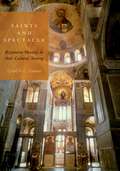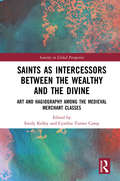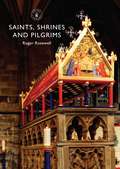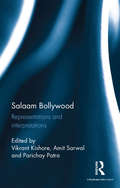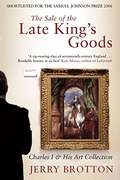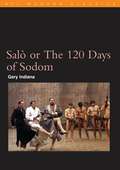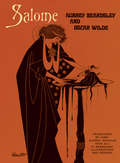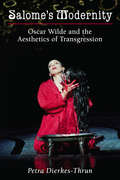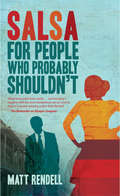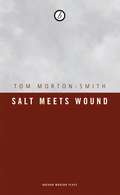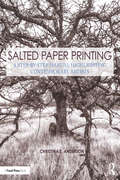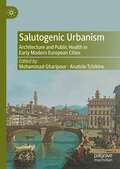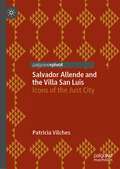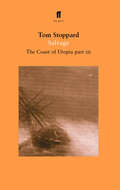- Table View
- List View
Saints and Spectacle: Byzantine Mosaics in their Cultural Setting
by Carolyn L. ConnorSaints and Spectacle examines the origins and reception of the Middle Byzantine program of mosaic decoration. This complex and colorful system of images covers the walls and vaults of churches with figures and compositions seen against a dazzling gold ground. The surviving eleventh-century churches with their wall and vault mosaics largely intact, Hosios Loukas, Nea Moni and Daphni in Greece, pose the challenge of how, when and where this complex and gloriously conceived system was created. Using an interdisciplinary approach, Connor explores the urban culture and context of church-building in Constantinople, capital of the Byzantine Empire, during the century following the end of Iconoclasm, of around 843 to 950. The application of an innovative frame of reference, through ritual studies, helps recreate the likely scenario in which the medium of mosaics attained its highest potential, in the mosaiced Byzantine church. For mosaics were enlisted to convey a religious and political message that was too nuanced to be expressed in any other way. At a time of revival of learning and the arts, and development of ceremonial practices, the Byzantine emperor and patriarch were united in creating a solution to the problem of consolidating the Greek Orthodox Byzantine Empire. It was through promoting a vision of the unchallengeable authority residing in God and his earthly representative, the emperor. The beliefs and processional practices affirming the protective role of the saints in which the entire city participated, were critical to the reception of this vision by the populace as well as the court. Mosaics were a luxury medium that was ideally situated aesthetically to convey a message at a particularly important historical moment--a brilliant solution to a problem that was to subtly unite an empire for centuries to come. Supported by a wealth of testimony from literary sources, Saints and Spectacle brings the Middle Byzantine church to life as the witness to a compelling and fascinating drama.
Saints as Intercessors between the Wealthy and the Divine: Art and Hagiography among the Medieval Merchant Classes (Sanctity in Global Perspective)
by Emily Kelley Cynthia Turner CampOffering snapshots of mercantile devotion to saints in different regions, this volume is the first to ask explicitly how merchants invoked saints, and why. Despite medieval and modern stereotypes of merchants as godless and avaricious, medieval traders were highly devout – and rightly so. Overseas trade was dangerous, and merchants’ commercial activities were seen as jeopardizing their souls. Merchants turned to saints for protection and succor, identifying those most likely to preserve their goods, families, reputations, and souls. The essays in this collection, written from diverse angles, range across later medieval western Europe, from Spain to Italy to England and the Hanseatic League. They offer a multi-disciplinary examination of the ways that medieval merchants, from petty traders to influential overseas wholesalers, deployed the cults of saints. Three primary themes are addressed: danger, community, and the unity of spiritual and cultural capital. Each of these themes allows the international panel of contributors to demonstrate the significant role of saints in mercantile life. This book is unique in its exploration of saints and commerce, shedding light on the everyday role religion played in medieval life. As such, it will be of keen interest to scholars of religious history, medieval history, art history, and literature.
Saints as Intercessors between the Wealthy and the Divine: Art and Hagiography among the Medieval Merchant Classes (Sanctity in Global Perspective)
Offering snapshots of mercantile devotion to saints in different regions, this volume is the first to ask explicitly how merchants invoked saints, and why. Despite medieval and modern stereotypes of merchants as godless and avaricious, medieval traders were highly devout – and rightly so. Overseas trade was dangerous, and merchants’ commercial activities were seen as jeopardizing their souls. Merchants turned to saints for protection and succor, identifying those most likely to preserve their goods, families, reputations, and souls. The essays in this collection, written from diverse angles, range across later medieval western Europe, from Spain to Italy to England and the Hanseatic League. They offer a multi-disciplinary examination of the ways that medieval merchants, from petty traders to influential overseas wholesalers, deployed the cults of saints. Three primary themes are addressed: danger, community, and the unity of spiritual and cultural capital. Each of these themes allows the international panel of contributors to demonstrate the significant role of saints in mercantile life. This book is unique in its exploration of saints and commerce, shedding light on the everyday role religion played in medieval life. As such, it will be of keen interest to scholars of religious history, medieval history, art history, and literature.
Saints, Shrines and Pilgrims (Shire Library #797)
by Roger RosewellIn the Middle Ages, it was thought that praying at the right shrine could save you from just about anything, from madness and famine to false imprisonment and even shipwreck. Kingdoms, cities, and even individual trades had patron saints that would protect them from misfortune and bring them wealth and prosperity, and their feast days were celebrated with public holidays and pageants. With saints believed to have the ear of God, veneration of figures such as St Thomas Becket, St Cuthbert, and St Margaret brought tens of thousands of pilgrims from all walks of life to sites across the country. Saints, Shrines and Pilgrims takes the reader across Britain, providing a map of the most important religious shrines that pilgrims would travel vast distances to reach, as well as descriptions and images of the shrines themselves. Featuring over 100 stunning photographs and a gazetteer of places to visit, it explains the history of pilgrimage in Britain and the importance that it played in medieval life, and describes the impact of the unbridled assault made on pilgrimage by the Reformation.
Saints, Shrines and Pilgrims (Shire Library #797)
by Roger RosewellIn the Middle Ages, it was thought that praying at the right shrine could save you from just about anything, from madness and famine to false imprisonment and even shipwreck. Kingdoms, cities, and even individual trades had patron saints that would protect them from misfortune and bring them wealth and prosperity, and their feast days were celebrated with public holidays and pageants. With saints believed to have the ear of God, veneration of figures such as St Thomas Becket, St Cuthbert, and St Margaret brought tens of thousands of pilgrims from all walks of life to sites across the country. Saints, Shrines and Pilgrims takes the reader across Britain, providing a map of the most important religious shrines that pilgrims would travel vast distances to reach, as well as descriptions and images of the shrines themselves. Featuring over 100 stunning photographs and a gazetteer of places to visit, it explains the history of pilgrimage in Britain and the importance that it played in medieval life, and describes the impact of the unbridled assault made on pilgrimage by the Reformation.
Salaam Bollywood: Representations and interpretations
by Vikrant Kishore Amit Sarwal Parichay PatraThis book traces the journey of popular Hindi cinema from 1913 to contemporary times when Bollywood has evolved as a part of India’s cultural diplomacy. Avoiding a linear, developmental narrative, the book re-examines the developments through the ruptures in the course of cinematic history. The essays in the volume critically consider transformations of the Hindi film industry from its early days to its present self-referential mode, issues of gender, dance and choreography, Bombay cinema’s negotiations with the changing cityscape and urbanisms, and concentrate on its multifarious regional, national and transnational implications in the 21st century. One of the most comprehensive volumes on Bollywood, this work presents an analytical overview of the multiple histories of popular cinema in India and will be useful to scholars and researchers interested in film and media studies, South Asian popular culture and modern India, as well as to cinephiles and general readers alike.
Salaam Bollywood: Representations and interpretations
by Vikrant Kishore Amit Sarwal Parichay PatraThis book traces the journey of popular Hindi cinema from 1913 to contemporary times when Bollywood has evolved as a part of India’s cultural diplomacy. Avoiding a linear, developmental narrative, the book re-examines the developments through the ruptures in the course of cinematic history. The essays in the volume critically consider transformations of the Hindi film industry from its early days to its present self-referential mode, issues of gender, dance and choreography, Bombay cinema’s negotiations with the changing cityscape and urbanisms, and concentrate on its multifarious regional, national and transnational implications in the 21st century. One of the most comprehensive volumes on Bollywood, this work presents an analytical overview of the multiple histories of popular cinema in India and will be useful to scholars and researchers interested in film and media studies, South Asian popular culture and modern India, as well as to cinephiles and general readers alike.
The Sale of the Late King's Goods: Charles I and His Art Collection
by Jerry BrottonSet against the backdrop of war, revolution, and regicide, and moving from London to Venice, Mantua, Madrid, Paris and the Low Countries, Jerry Brotton’s colourful and critically acclaimed book, The Sale of the Late King's Goods, explores the formation and dispersal of King Charles I’s art collection. Following a remarkable and unprecedented Parliamentary Act for ‘The sale of the late king’s goods’, Cromwell’s republican regime sold off nearly 2,000 paintings, tapestries, statues and drawings in an attempt to settle the dead king’s enormous debts and raise money for the Commonwealth’s military forces. Brotton recreates the extraordinary circumstances of this sale, in which for the first time ordinary working people were able to handle and own works by the great masters. He also examines the abiding relationship between art and power, revealing how the current Royal Collection emerged from this turbulent period, and paints its own vivid and dramatic picture of one of the greatest lost collections in English history.
Salesforce Lightning Reporting and Dashboards
by Johan YuLearn how to build advanced reports and dashboards in Salesforce Lightning experience About This Book • Visualize and create advanced reports and dashboards using Lightning Experience • Improve overall business efficiency with advanced and effective reports and dashboards • Understand and create custom reports and dashboards Who This Book Is For This book is targeted at Salesforce.com administrators, business analysts, and managers who use Salesforce.com for their daily job and want to learn in depth about Salesforce Reporting and Dashboard in Lightning Experience. Readers should have a basic knowledge of Salesforce, such as: Accounts, Contacts, Leads, Opportunities and custom objects. What You Will Learn • Navigate in Salesforce.com within the Lightning Experience user interface • Secure and share your reports and dashboards with other users • Create, manage, and maintain reports using Report Builder • Learn how the report type can affect the report generated • Explore the report and dashboard folder and the sharing model • Create reports with multiple formats and custom report types • Explore various dashboard features in Lightning Experience • Use Salesforce1, including accessing reports and dashboards In Detail Built on the Salesforce App Cloud, the new Lightning Experience combines the new Lightning Design System, Lightning App Builder, and Lightning Components to enable anyone to quickly and easily create modern enterprise apps. The book will start with a gentle introduction to the basics of Salesforce reports and dashboards. It will also explain how to access reports in depth. Then you will learn how to create and manage reports, to use Schedule Report, and create advanced report configurations. The next section talks about dashboards and will enable you to understand and compare various types of dashboard component and how you can benefit the most from each of them. Then we move on to advanced topics and explain tips and tricks related to reports and dashboards, including reporting snapshots, report parameters, and collaboration. Finally, we will discuss how to access dashboards and reports from the Salesforce1 mobile app. Style and approach This comprehensive guide covers the advanced features of the all new Salesforce Lightning concepts and communicates them through a practical approach to explore the underlying concepts of how, when, and why to use them.
Salesman (BFI Film Classics)
by J.M. TyreeSelected by the Library of Congress as one of the most significant American films ever made, Salesman (1966–9) is a landmark in non-fiction cinema, equivalent in its impact and influence to Truman Capote's 'non-fiction novel' In Cold Blood. The film follows a team of travelling Bible salesmen on the road in Massachusetts, Chicago, and Florida, where the American dream of self-reliant entrepreneurship goes badly wrong for protagonist Paul Brennan. Long acknowledged as a high-water mark of the 'direct cinema' movement, this ruefully comic and quietly devastating film was the first masterpiece of Albert Maysles, David Maysles and Charlotte Zwerin, the trio who would go on to produce The Rolling Stones documentary, Gimme Shelter (1970).Based on the premise that films drawn from ordinary life could compete with Hollywood extravaganzas, Salesman was critical in shaping 'the documentary feature'. A novel cinema-going experience for its time, the film was independently produced, designed for theatrical release and presented without voiceover narration, interviews, or talking heads. Working with innovative handheld equipment, and experimenting with eclectic methods and a collaborative ethos, the Maysles brothers and Zwerin produced a carefully-orchestrated narrative drama fashioned from unexpected episodes.J. M. Tyree suggests that Salesman can be understood as a case study of non-fiction cinema, raising perennial questions about reality and performance. His analysis provides an historical and cultural context for the film, considering its place in world cinema and its critical representations of dearly-held national myths. The style of Salesman still makes other documentaries look static and immobile, while the film's allegiances to everyday subjects and working people indelibly marked the cinema. Tyree's insightful study also includes an exclusive exchange with Albert Maysles about the film.
Salesman (BFI Film Classics)
by J.M. TyreeSelected by the Library of Congress as one of the most significant American films ever made, Salesman (1966–9) is a landmark in non-fiction cinema, equivalent in its impact and influence to Truman Capote's 'non-fiction novel' In Cold Blood. The film follows a team of travelling Bible salesmen on the road in Massachusetts, Chicago, and Florida, where the American dream of self-reliant entrepreneurship goes badly wrong for protagonist Paul Brennan. Long acknowledged as a high-water mark of the 'direct cinema' movement, this ruefully comic and quietly devastating film was the first masterpiece of Albert Maysles, David Maysles and Charlotte Zwerin, the trio who would go on to produce The Rolling Stones documentary, Gimme Shelter (1970).Based on the premise that films drawn from ordinary life could compete with Hollywood extravaganzas, Salesman was critical in shaping 'the documentary feature'. A novel cinema-going experience for its time, the film was independently produced, designed for theatrical release and presented without voiceover narration, interviews, or talking heads. Working with innovative handheld equipment, and experimenting with eclectic methods and a collaborative ethos, the Maysles brothers and Zwerin produced a carefully-orchestrated narrative drama fashioned from unexpected episodes.J. M. Tyree suggests that Salesman can be understood as a case study of non-fiction cinema, raising perennial questions about reality and performance. His analysis provides an historical and cultural context for the film, considering its place in world cinema and its critical representations of dearly-held national myths. The style of Salesman still makes other documentaries look static and immobile, while the film's allegiances to everyday subjects and working people indelibly marked the cinema. Tyree's insightful study also includes an exclusive exchange with Albert Maysles about the film.
Salo (BFI Film Classics)
by Gary IndianaBeneath the extreme, taboo-breaking surface of 'Salo' (a controversial and scandalous film made in 1975), Gary Indiana argues that there's a deeply penetrating account of human behaviour which resonates as an account of fascism and as a picture of the corporate world we live in. 'Salo' was Pier Pasolini's last film (he was murdered shortly after completing it). An adaptation of Sade's vicious masterpiece, it is an unflinching, violent portrayal of sexual cruelty which many find too disturbing to watch.
Salo (BFI Film Classics)
by Gary IndianaBeneath the extreme, taboo-breaking surface of 'Salo' (a controversial and scandalous film made in 1975), Gary Indiana argues that there's a deeply penetrating account of human behaviour which resonates as an account of fascism and as a picture of the corporate world we live in. 'Salo' was Pier Pasolini's last film (he was murdered shortly after completing it). An adaptation of Sade's vicious masterpiece, it is an unflinching, violent portrayal of sexual cruelty which many find too disturbing to watch.
Salome: A Tragedy In One Act (Dover Fine Art, History Of Art Series)
by Oscar Wilde Aubrey BeardsleyFew works in English literature have so peculiar a history as Oscar Wilde's play Salome. Written originally in French in 1892 and ridiculed on its publication, translated into English by Lord Alfred Douglas ("Bosie" himself) and again heaped with scorn, it has survived for 75 years, served as the text (in abridged form) for Richard Strauss' world-famous opera, and emerged as an acknowledged masterwork of the Aesthetic movement of fin de siècle England.The illustrations that Aubrey Beardsley prepared for the first English edition have no less strange a story. Beardsley liked neither the play nor its author. Yet, it inspired some of his finest work. It is an open question as to how suited the drawings actually are to the text that Wilde wrote. Yet, the two, the play and the Beardsley illustrations, have nevertheless become so identified with each other as to be inseparable.This edition reprints the first edition (1894) text, with "A Note on 'Salome'" by Robert Ross. The Beardsley drawings it superbly reproduces (mostly from a rare early portfolio) include not only the 10 full-page illustrations, the front and back cover designs, the title and List of Illustrations page decorations, and the cul de lampe from the original edition, but also three drawings that were not used, an alternate cover sketch, and the drawing entitled "J'ai baisé ta bouche, Iokanaan," which Beardsley did earlier for The Studio. Furthermore, all of the illustrations are reproduced in their original state, not as expurgated in the first and most subsequent editions.
Salome's Modernity: Oscar Wilde and the Aesthetics of Transgression
by Petra Dierkes-ThrunOscar Wilde's 1891 symbolist tragedy Salomé has had a rich afterlife in literature, opera, dance, film, and popular culture. Salome's Modernity: Oscar Wilde and the Aesthetics of Transgression is the first comprehensive scholarly exploration of that extraordinary resonance that persists to the present. Petra Dierkes-Thrun positions Wilde as a founding figure of modernism and Salomé as a key text in modern culture's preoccupation with erotic and aesthetic transgression, arguing that Wilde's Salomé marks a major turning point from a dominant traditional cultural, moral, and religious outlook to a utopian aesthetic of erotic and artistic transgression. Wilde and Salomé are seen to represent a bridge linking the philosophical and artistic projects of writers such as Mallarmé, Pater, and Nietzsche to modernist and postmodernist literature and philosophy and our contemporary culture. Dierkes-Thrun addresses subsequent representations of Salome in a wide range of artistic productions of both high and popular culture through the works of Richard Strauss, Maud Allan, Alla Nazimova, Ken Russell, Suri Krishnamma, Robert Altman, Tom Robbins, and Nick Cave, among others.
Salsa for People Who Probably Shouldn't
by Matt RendellEvery week for much of the year, millions of Brits view and vote on Strictly Come Dancing, with the salsa being one of the most popular dances. Dark, enticing Afro-Caribbean rhythms; moving bodies gently interlaced, responding to the music: at first sight, salsa dancing seems to recover something our regimented British lives suppress. For not much more than a fiver, salsa can reconnect us with our bodies. So we seem to think: with perhaps a million Britons taking a class every week, salsa is statistically our national dance.Matt Rendell learned salsa the British way, as an adult, rote-learning figures and routines. His Colombian wife, Vivi, acquired salsa in early childhood from her parents and grandparents; the dance made her part of her community.A love story about two people from cultures at sometimes comical cross-purposes, Salsa for People Who Probably Shouldn't explores how the world's most popular dance went global, how it reached the UK and whether the saucy, salacious salsa of our national fantasy life is really as exotic as we like to think.
Salt Meets Wound (Oberon Modern Plays)
by Tom Morton-SmithDylan Singer needs to leave London. With his alcoholic ex-fiancée he heads to Central Asia, to research the book he's always dreamt of writing. But it's 2002, the height of the War on Terror, and Uzbekistan isn't the belly-dancing opium den they have been led to believe.From 11th Century Samarkand, through the Great Fire of London, to a disused weapons facility in the remotest place on earth, Salt Meets Wound is an epic odyssey spanning a thousand years.Tom Morton-Smith's debut is a magnificent delve into the jigsaw pieces of modern events and history. It opened at the Theatre503 in May 2007.
Salted Paper Printing: A Step-by-Step Manual Highlighting Contemporary Artists (Contemporary Practices in Alternative Process Photography)
by Christina Z. AndersonSalted Paper Printing: A Step-by-Step Manual Highlighting Contemporary Artists makes one of the oldest known photographic processes easy for the 21st century using simple digital negative methods. Christina Z. Anderson’s in-depth discussion begins with a history of salted paper printing, then covers the salted paper process from beginner to intermediate level, with step-by-step instructions and an illustrated troubleshooting guide. Including cameraless imagery, hand-coloring, salt in combination with gum, and printing on fabric, Salted Paper Printing contextualizes the practice within the varied alternative processes. Anderson offers richly-illustrated profiles of contemporary artists making salted paper prints, discussing their creative process and methods. Salted Paper Printing is perfect for the seasoned photographer looking to dip their toe into alternative processes, or for the photography student eager to engage with photography’s rich history.
Salted Paper Printing: A Step-by-Step Manual Highlighting Contemporary Artists (Contemporary Practices in Alternative Process Photography)
by Christina Z. AndersonSalted Paper Printing: A Step-by-Step Manual Highlighting Contemporary Artists makes one of the oldest known photographic processes easy for the 21st century using simple digital negative methods. Christina Z. Anderson’s in-depth discussion begins with a history of salted paper printing, then covers the salted paper process from beginner to intermediate level, with step-by-step instructions and an illustrated troubleshooting guide. Including cameraless imagery, hand-coloring, salt in combination with gum, and printing on fabric, Salted Paper Printing contextualizes the practice within the varied alternative processes. Anderson offers richly-illustrated profiles of contemporary artists making salted paper prints, discussing their creative process and methods. Salted Paper Printing is perfect for the seasoned photographer looking to dip their toe into alternative processes, or for the photography student eager to engage with photography’s rich history.
Salutogenic Urbanism: Architecture and Public Health in Early Modern European Cities
by Mohammad Gharipour Anatole TchikineThis book offers a new, salutogenic, perspective on the development of early modern cities by exploring profound and complex ways in which architecture and landscape design served to promote public health on an urban scale. Focusing on fifteenth- through nineteenth-century Europe, it addresses the histories of spaces and institutions that supported salubrious living, highlighting the intersections of medical theory, government policy, and architectural practice in designing, improving, and monumentalizing the infrastructure of sanitation and healthcare. Studies in this book highlight the joint role of design thinking and scientific practice in reforming the facilities for treating and preventing disease; the impact of cross-cultural exchange on early modern strategies of urban improvement; and the creation of new therapeutic environments through state, communal, and private initiatives concerned with the preservation of physical and mental health, from recreational landscapes to spa resorts.
Salvador Allende and the Villa San Luis: Icons of the Just City
by Patricia VilchesThrough the history of this housing complex, this book illuminates Salvador Allende’s dedication to the imperative of the right to the city for Chile’s marginalized people. Built in affluent Las Condes in Santiago, on what is arguably the most expensive parcel of land in Chile, the Villa San Luis was one of Salvador Allende’s most visible and dramatic social projects. Allende’s six-year term was ended in the middle by a military coup d’état on 11th September 1973. Yet, material culture from Villa San Luis remains to convey the legacy of his commitment to providing disadvantaged families with dignified housing. It is a national lieu de mémoire and an iconic space, a reminder of a truly remarkable innovation in social housing and of Allende’s personal and political commitment to making Santiago a just city. Postcoup, the remains of the complex also relate the wider injustice of the Pinochet regime. Many of its families were violently evicted during the dictatorship. Some were dispossessed, taken away from Las Condes in garbage trucks, and dumped in poor communities around Santiago. The land was usurped by Pinochet on behalf of the army and later sold to developers to construct high-rise symbols of a new, neoliberal Chile. Over the decades, however, former residents fought back and, in 2020, they succeeded in making its one remaining structure, remnants of Block 14, a memorialized place of justice and reconciliation. It now a national monument and museum.
Salvador Dali: 16 Art Stickers (Pocket Library of Art)
by Keith PointingSalvador Dali was arguably the twentieth century’s leading surrealist and this sumptuously illustrated monograph, now available as an eBook, provides a good introduction to his most famous paintings, including Swans Reflecting Elephants, Sublime Moment and The Persistence of Memory. View this eBook on your iPad or Android to fully appreciate the lavish full colour illustrations.
Salvador Dali (large print)
by RnibThis image shows a portrait of Salvador Dali. There is a locator dot shown, which will be at the top left of the page when the image is the correct way up. He is facing you so all facial features can be found. Only his head, neck and some of his shoulders are shown. His black hair is cut in a very neat and tidy style. He has large black eyebrows. Down from them he stares with very wide brown eyes, they are nearly popping out. He has a long thin moustache which curves round down from, and just left and right of each eye. It ends in sharp points. He wears a smart jacket and tie. He has a handkerchief poking out of the jacket breast pocket in the bottom right of the image. The image is surrounded by an image border.
Salvage: The Coast of Utopia Play 3 (The\coast Of Utopia Trilogy #Pt. 3)
by Tom StoppardSalvage is the final part of Tom Stoppard's trilogy The Coast of Utopia. It is 1852. Alexander Herzen, who left Russia five years earlier, has arrived in London in retreat from a series of public and private calamities. Revolution in Europe has hit the rocks. 'I have lost every illusion dear to me,' he says. 'I'm forty. The world will hear no more of me.' But émigré circles in London (including Karl Marx) are buzzing with plots and intrigues, and Herzen's money, as well as his sardonic wit, soon have an outlet among them. With the accession of Alexander II, 'the Reforming Tsar', Herzen's revived spirits are boosted by the arrival of his childhood friend Nicholas Ogarev with his wife Natalie. Their journal 'The Bell', smuggled into Russia, enters its heyday in the struggle for the emancipation of the serfs. Will it be reform from above or revolution from below? At home the 'new men' who once looked on Herzen as their inspiration are in a hurry, and in London he is once more at odds with Michael Bakunin, who has escaped from exile in Siberia. Meanwhile Natalie Ogarev finds in him her romantic ideal, and Herzen's public and private travails are far from over.
Salvaging Buildings: Reclaiming a Livelihood from the Excesses of Istanbul's Mass Urbanization (Architekturen #79)
by Erdogan Onur CeritogluFor at least two decades, major cities in Turkey have been subjected to endless waves of urban development that has left scores of building demolitions in its wake. The construction waste produced is immense but its removal or abatement is completely ignored by the state. Who will deal with all this waste? Enter the reclaimers (çkmacs), an informal network of building salvagers, who have stepped in to create a new form of assemblage that fills this gap. Erdogan Onur Ceritoglu makes an in-depth ethnographic study of the under-the-radar livelihood of the reclaimers long-term. He also focuses on incremental architecture through the reuse of second-hand building elements.
